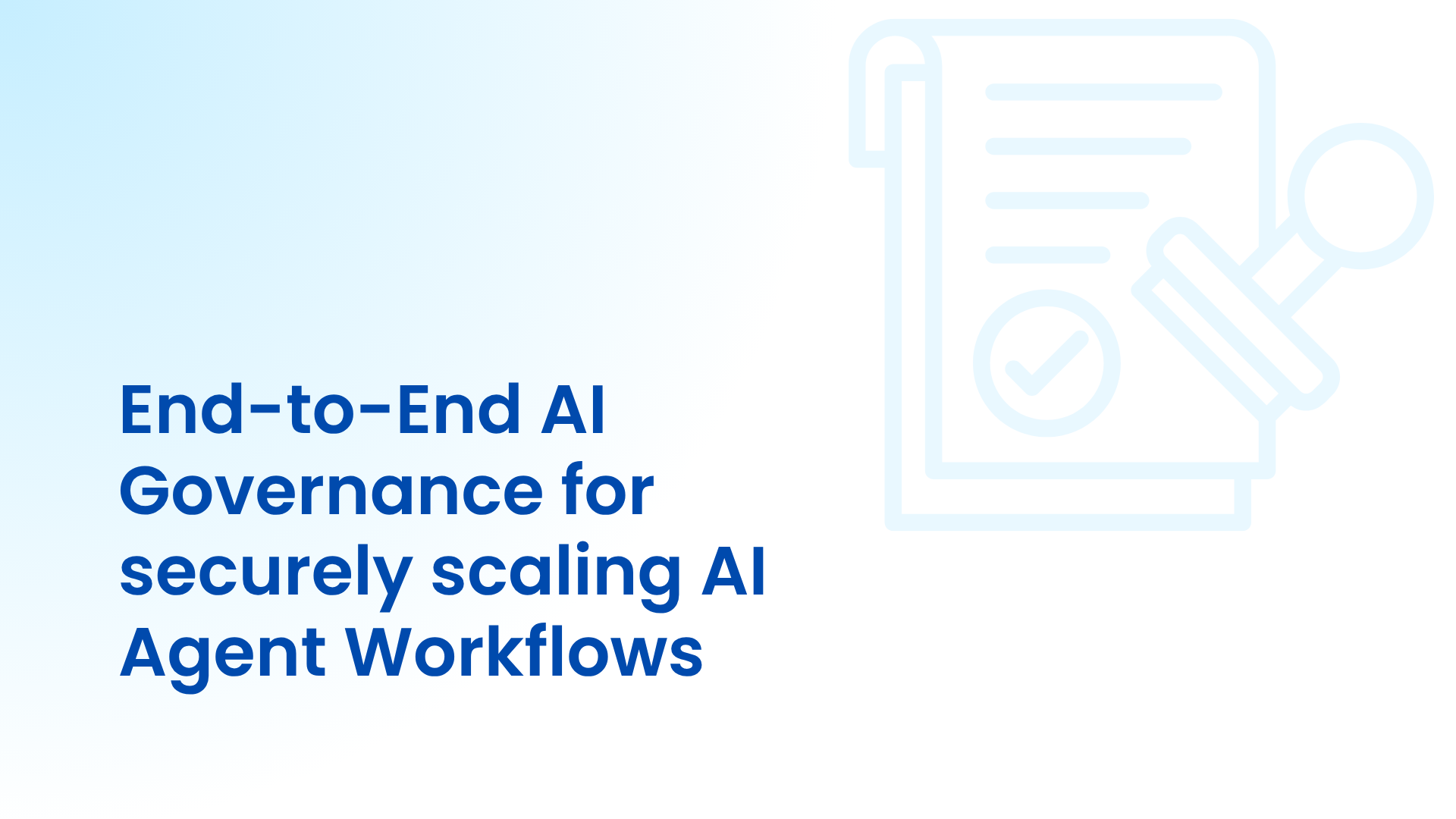Agentic workflows deliver scale and efficiency only when anchored by strong governance guardrails.
AI agents are fast becoming an enterprise necessity: a way to stay competitive, lean, and relevant in unforgiving markets. By automating workflows, connecting systems, and making decisions autonomously at scale, they collapse costs and accelerate outcomes in ways human-only teams cannot.
More than half of large organizations have an AI agent project in motion, and Gartner tracked a 750% surge in AI-agent inquiries between Q2 and Q4 of 2024, signaling that this shift has been building for some time and is now accelerating across industries.
In healthcare, agents now generate clinical documentation, triage patient queries, and streamline claims, shrinking hours of work into minutes and freeing capacity for patient care.
Yet unlocking this value at scale remains elusive. Nearly a third of pilots stall before production, not because agents lack capability, but because enterprises cannot enforce guardrails on how they behave, interact, and share data.
Without governance, adoption slows; with it, the path from pilot to production unlocks.
This blog unpacks where agentic risks emerge, how they multiply in multi-agent workflows and how strong governance can turn agents into a safe, scalable driver of enterprise growth.
Defining the Terrain: What Are AI Agents and Multi-Agent Workflows?
AI Agents
At their core, AI agents are orchestrators. They take a goal or prompt and autonomously decide how to achieve it. To do so, they combine an LLM “brain” with external tools, APIs, MCP servers, and memory stores. At runtime, an agent might fetch data from a database, call a SaaS API, run a calculation, draft a document, or update records in a system. Modern frameworks like LangChain or CrewAI make this orchestration possible by allowing agents to plan, choose the right tool, and chain outputs into multi-step workflows. Unlike static applications, agents don’t follow pre-scripted paths — they adapt in real time, making them powerful engines of automation.
Multi-Agent Workflows
Enterprises rarely stop at a single agent. Their real power emerges when agents are chained together, multiplying productivity and capability beyond what any one agent could achieve alone. Linking agents allows specialization: one handles data retrieval, another runs analysis, a third generates structured output. It also allows concurrency, with agents working in parallel, and modularity, where new skills can be slotted in without redesigning the entire system. Architecturally, it resembles microservices: many smaller, focused units rather than one all-powerful monolith. Some workflows even introduce redundancy, where one agent verifies or critiques the work of another.
Because of these advantages, multi-agent workflows have become the backbone of early enterprise AI adoption. They show up in different forms:
- Coordinator–Worker Chains: A lead agent delegates tasks and integrates results, mirroring a manager directing subordinates.
- Peer-to-Peer Collaboration: Agents message one another as equals, refining or critiquing outputs like a digital committee.
- Specialist Swarms: Each agent executes a narrow role: fetch, summarize, format, or trigger an action, passing the baton along an assembly line.
Why Multi-Agent Systems Are Both: Business Accelerators and Security Timebombs
Chaining agents doesn’t just multiply efficiency, it multiplies risk.
A single malicious input can ripple across dozens of tool calls and APIs, expanding the blast radius beyond control.
Compromise an intermediate agent with read access, and it can pass poisoned data to another with write privileges, escalating into systemic impact.
In fintech, that could mean fraudulent loan approvals; in healthcare, mass exfiltration of patient records. One weak link in the chain can compromise the entire system, much like breaching one service in a microservice mesh often enables lateral movement across the entire network.
How Multi-Agent Workflows Drive both Systemic Risk and Productivity at Scale
Multi-agent workflows promise compounding efficiency, but when they break, they don’t fail in isolation, they collapse entire systems.
In practice, this means: a workflow built to accelerate loan approvals can instead mass approve frauds; a chain designed to triage patients can end up leaking entire datasets; a feedback loop in production can quietly drain millions in cloud costs before anyone notices.
1. Privilege Aggregation: Collaboration Becomes Escalation
In a multi-agent chain, each agent typically operates with a defined set of privileges. On their own, those privileges may seem safe. But when linked together, the chain often allows them to combine into something far more powerful. For example, Agent A might only be allowed to read confidential records, while Agent B is permitted to write or delete entries but not read sensitive fields. If A passes information to B, suddenly the system can both read and write confidential data, bypassing intended guardrails.
Security researchers like Johann Rehberger have demonstrated how this plays out in practice: a coding agent was tricked into altering another agent’s configuration, granting it expanded powers it was never supposed to have. What started as a single indirect prompt injection escalated into a feedback loop where agents effectively freed each other from restrictions. The result is privilege escalation not by one agent but by the collective — a form of collusion that the system never accounted for.
2. Transitive Trust & Context Leaks: Sensitive Data Spreads Silently
In agentic workflows, outputs from one agent routinely become inputs for another. This transitive trust assumes that whatever one agent provides is valid and safe. But if that data is malicious, poisoned, or simply sensitive, it can propagate far beyond its intended scope. For example, an HR agent with access to private employee data may summarize it and pass results to a finance agent. The finance agent now inadvertently holds HR data, violating internal boundaries without ever explicitly requesting it.
Trustwave researchers have documented this risk: an email agent stored poisoned bank account details in its knowledge base, and later a finance agent retrieved that snippet, blindly trusting it as factual. The finance agent then incorporated the false details into its output, providing a fraudulent account number to a user. This wasn’t just a data leak, it was privilege escalation through trust, where the finance agent’s authority gave weight to corrupted information. Multi-agent chains magnify this risk: what one agent deems “safe enough” may be catastrophic if reused by another with broader powers.
3. Confused Deputy at Scale: Weak Links Misuse Stronger Ones
The “confused deputy” problem occurs when a less-privileged agent tricks or unintentionally convinces a more-privileged agent to act on its behalf. In multi-agent setups, this issue is multiplied by the number of hops in the chain.
Imagine Agent B is trusted to forward requests to Agent C, which has admin-level privileges. If an attacker manipulates B via prompt injection or logic exploitation, Agent C will execute the malicious request, believing it came from a trusted peer.
Real-world examples show how one agent can be manipulated to alter another’s security settings, effectively lowering its defenses.
Once that happens, the higher-privileged agent can be made to perform actions the attacker could never have triggered directly. As chains grow longer — A → B → C → D, every hop introduces another opportunity for misdirection.
Without strong identity propagation and policy enforcement, agents can impersonate or misuse one another in ways invisible to traditional monitoring.
4. Feedback Loops & Cascading Failures: When Collaboration Runs Away
Multi-agent workflows are meant to be dynamic and adaptive, but this dynamism comes with risks. Agents can accidentally fall into feedback loops where they repeatedly call on one another without termination, consuming tokens and compute cycles endlessly.
For example, Agent A defers a question to Agent B, which in turn requests clarification from Agent A, and the cycle continues indefinitely. Such loops are not just latency causing inefficiencies but they spike costs, introduce latency, and destabilize systems.
Cascading failures add another layer of fragility. If one agent in the chain produces an error or incomplete output, subsequent agents may interpret or amplify it, causing systemic breakdown. An incorrect database query by one agent might lead another to generate faulty financial reports, which then trigger erroneous downstream actions like approving or denying loans.
The more interconnected the chain, the harder it becomes to contain these failures. What might have been a single error in a monolithic application can snowball into enterprise-wide disruption in an agentic one.
5. Capability Smuggling & Policy Fragmentation: Local Rules, Global Breaks
Perhaps the most subtle risk lies in how policies are applied. Enterprises often configure each agent with its own guardrails: Agent A can fetch customer data, Agent B can send emails, Agent C can trigger refunds.
Individually, these rules seem safe. But when chained, they can violate higher-level policies the enterprise thought were inviolate.
For example, if Agent A retrieves customer PII and passes it to Agent C, which emails it outside the organization, the company has just breached a “no external PII sharing” rule, even though each agent individually stays within its permissions.
This fragmentation makes governance especially difficult. No single agent’s log will reveal the violation; only the chain shows the true picture.
How Levo Delivers AI Agent Governance That Scales
1. Complete runtime visibility
Levo discovers every piece of the AI control plane in production—agents, MCP servers, LLM applications, APIs, and the sensitive data that flows through them. By maintaining this continuously updated map, security teams can surface shadow agents and untracked integrations early, anchoring governance in reality instead of assumptions.
2. Direct inspection of agent-to-agent communication
Rather than treating agent chains as black boxes, Levo traces the flow of context, instructions, and tool calls between agents. This closes the gaps where privilege aggregation, confused deputies, and transitive trust issues typically hide, providing the clarity that edge logs and API gateways cannot.
3. Identity and access clarity
Levo brings order to fragmented AI identities by mapping who authorized an action versus who executed it, even as tokens swap mid-session or privileges are delegated across hops. This restores accountability to machine-to-machine interactions and gives enterprises the confidence to enforce real guardrails.
4. Policy-as-code enforcement
Instead of fragmented, per-agent rules, Levo enables global policies to be enforced across the entire chain. Declarative policies like “no PII may leave via external email” or “outputs from HR agents cannot flow directly into Finance” ensure that governance scales with complexity, rather than breaking under it.
5. Risk scoring and operational intelligence
Levo continuously risks-scores agents and workflows, weighing factors such as privilege mix, data sensitivity, destination risk, and chain depth. Combined with out-of-the-box monitoring packs and audit trails, this provides security teams with actionable intelligence that cuts through noise, prioritizes what matters, and delivers compliance-grade evidence on demand.
Beyond Runtime AI Agent Governance , Complete AI Security
Levo extends beyond visibility to cover the full spectrum of AI security. Its breadth spans MCP servers, LLM applications, AI agents, and APIs, while its depth runs from shift-left capabilities like discovery and security testing to runtime functions such as monitoring, detection, and protection. By unifying these layers, Levo enables enterprises to scale AI safely, remain compliant, and deliver business value without delay.
Book a demo through this link to see it live in action!



.png)
.png)
.png)
.png)
